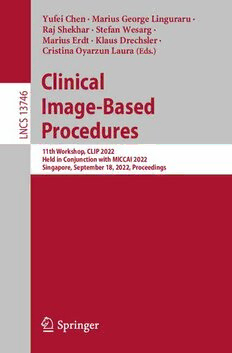
Clinical Image-Based Procedures: 11th Workshop, CLIP 2022, Held in Conjunction with MICCAI 2022, Singapore, September 18, 2022, Proceedings PDF
Preview Clinical Image-Based Procedures: 11th Workshop, CLIP 2022, Held in Conjunction with MICCAI 2022, Singapore, September 18, 2022, Proceedings
Yufei Chen · Marius George Linguraru · Raj Shekhar · Stefan Wesarg · Marius Erdt · Klaus Drechsler · Cristina Oyarzun Laura (Eds.) Clinical 6 4 Image-Based 7 3 1 S Procedures C N L 11th Workshop, CLIP 2022 Held in Conjunction with MICCAI 2022 Singapore, September 18, 2022, Proceedings Lecture Notes in Computer Science 13746 FoundingEditors GerhardGoos KarlsruheInstituteofTechnology,Karlsruhe,Germany JurisHartmanis CornellUniversity,Ithaca,NY,USA EditorialBoardMembers ElisaBertino PurdueUniversity,WestLafayette,IN,USA WenGao PekingUniversity,Beijing,China BernhardSteffen TUDortmundUniversity,Dortmund,Germany MotiYung ColumbiaUniversity,NewYork,NY,USA Moreinformationaboutthisseriesathttps://link.springer.com/bookseries/558 · · Yufei Chen Marius George Linguraru · · · Raj Shekhar Stefan Wesarg Marius Erdt · Klaus Drechsler Cristina Oyarzun Laura (Eds.) Clinical Image-Based Procedures 11th Workshop, CLIP 2022 Held in Conjunction with MICCAI 2022 Singapore, September 18, 2022 Proceedings Editors YufeiChen MariusGeorgeLinguraru TongjiUniversity Children’sNationalHealthSystem Shanghai,China Washington,DC,USA RajShekhar StefanWesarg Children’sNationalHealthSystem FraunhoferIGD Washington,DC,USA Darmstadt,Germany MariusErdt KlausDrechsler FraunhoferSingapore AachenUniversityofAppliedSciences Singapore,Singapore Aachen,Germany CristinaOyarzunLaura FraunhoferIGD Darmstadt,Germany ISSN 0302-9743 ISSN 1611-3349 (electronic) LectureNotesinComputerScience ISBN 978-3-031-23178-0 ISBN 978-3-031-23179-7 (eBook) https://doi.org/10.1007/978-3-031-23179-7 ©TheEditor(s)(ifapplicable)andTheAuthor(s),underexclusivelicense toSpringerNatureSwitzerlandAG2023 Thisworkissubjecttocopyright.AllrightsarereservedbythePublisher,whetherthewholeorpartofthe material is concerned, specifically the rights of translation, reprinting, reuse of illustrations, recitation, broadcasting, reproduction on microfilms or in any other physical way, and transmission or information storageandretrieval,electronicadaptation,computersoftware,orbysimilarordissimilarmethodologynow knownorhereafterdeveloped. Theuseofgeneraldescriptivenames,registerednames,trademarks,servicemarks,etc.inthispublication doesnotimply,evenintheabsenceofaspecificstatement,thatsuchnamesareexemptfromtherelevant protectivelawsandregulationsandthereforefreeforgeneraluse. Thepublisher,theauthors,andtheeditorsaresafetoassumethattheadviceandinformationinthisbookare believedtobetrueandaccurateatthedateofpublication.Neitherthepublishernortheauthorsortheeditors give a warranty, expressed or implied, with respect to the material contained herein or for any errors or omissionsthatmayhavebeenmade.Thepublisherremainsneutralwithregardtojurisdictionalclaimsin publishedmapsandinstitutionalaffiliations. ThisSpringerimprintispublishedbytheregisteredcompanySpringerNatureSwitzerlandAG Theregisteredcompanyaddressis:Gewerbestrasse11,6330Cham,Switzerland Preface The11thInternationalWorkshoponClinicalImage-basedProcedures:TowardsHolistic PatientModelsforPersonalisedHealthcare(CLIP)washeldonSeptember18,2022,in conjunctionwiththe25thInternationalConferenceonMedicalImageComputingand ComputerAssistedIntervention(MICCAI2022). FollowingthelongtraditionofCLIPontranslationalresearch,thegoaloftheworks presented in this workshop is to bring basic research methods closer to the clinical practice.Oneofthekeyaspectsthatisgainingrelevanceregardingtheapplicabilityof basicresearchmethodsinclinicalpracticeisthecreationofHolisticPatientModelsasan importantsteptowardspersonalisedhealthcare.Asamatteroffact,theclinicalpicture ofapatientdoesnotuniquelyconsistofmedicalimages,butacombinationofmedical imagedataofmultiplemodalitieswithotherpatientdata,e.g.,omics,demographicsor electronic health records is desirable. Since 2019 CLIP has put a special emphasis on thisareaofresearch. CLIP 2022 received 12 submissions and 9 of them were accepted for publication. Allsubmittedpaperswerepeer-reviewedbyatleast3experts.Allacceptedpaperswere presentedbytheirauthorsduringtheworkshopandtheattendeeschosewiththeirvotes theholderoftheBestPaperAwardofCLIP2022.Inadditiontotheoralpresentations provided by the authors of the accepted papers, all attendees of CLIP 2022 had the opportunity to enjoy high-quality keynotes followed by avid discussions in which all attendeeswereinvolved.Wewouldliketothankourinvitedspeakersfortheirinteresting talksanddiscussions: Prof.XiahaiZhuang,FudanUniversity,Shanghai,China,“UsingStatisticalLearn- ing to Improve Interpretation and Generalization in Medical Image Computing and Analysis”(online). Dr. Moti Freiman, Technion, Israel, “MR Physics Driven Artificial Intelligence” (on-site). Furthermore, we would like to take this opportunity to thank also our program committeemembers,authorsandattendeeswhohelpedCLIP2022tobeagreatsuccess. September2022 YufeiChen MariusGeorgeLinguraru RajShekhar StefanWesarg MariusErdt KlausDrechsler CristinaOyarzunLaura Organization OrganizingCommittee YufeiChen TongjiUniversity,Shanghai,China KlausDrechsler AachenUniversityofAppliedSciences,Germany MariusErdt FraunhoferSingapore,Singapore MariusGeorgeLinguraru Children’sNationalHealthcareSystem,USA CristinaOyarzunLaura FraunhoferIGD,Germany RajShekhar Children’sNationalHealthcareSystem,USA StefanWesarg FraunhoferIGD,Germany ProgramCommittee NiklasBabendererde TechnicalUniversityDarmstadt,Germany JanEgger GrazUniversityofTechnology,Austria MotiFreiman Technion-IsraelInstituteofTechnology,Israel MoritzFuchs TechnicalUniversityDarmstadt,Germany CamilaGonzalez TechnicalUniversityDarmstadt,Germany Anna-SophiaHertlein FraunhoferIGD,Germany KatarzynaHeryan UniversityofScienceandTechnology,Poland MartinHoßbach ClearGuideMedical,USA YogeshKarpate ChistatsLabsPrivateLimited,India PurnimaRajan ClearGuideMedical,USA AndreasWirtz FraunhoferIGD,Germany LukasZerweck FraunhoferITMP,Germany StephanZidowitz FraunhoferMEVIS,Germany Contents FastAuto-differentiableDigitallyReconstructedRadiographsforSolving InverseProblemsinIntraoperativeImaging ................................ 1 VivekGopalakrishnanandPolinaGolland Multi-channelResidualNeuralNetworkBasedonSqueeze-and-Excitation forOsteoporosisDiagnosis .............................................. 12 ChunmeiXia, YueDing, JionglinWu, WenqiangLuo, PeidongGuo, TianfuWang,andBaiyingLei MachineLearningBasedApproachforMotionDetectionandEstimation inRoutinelyAcquiredLowResolutionNearInfraredFluorescenceOptical Imaging ............................................................... 22 LukasZerweck,StefanWesarg,JörnKohlhammer,andMichaelaKöhm AutomaticLandmarkIdentificationonIntraOralScans ....................... 32 BaptisteBaquero, MaximeGillot, LuciaCevidanes, NajlaAlTurkestani,MarcelaGurgel,MathieuLeclercq,JonasBianchi, MariliaYatabe, AntonioRuellas, CamilaMassaro, AronAliaga, MariaAntoniaAlvarezCastrillon,DiegoRey,JuanFernandoAristizabal, andJuanCarlosPrieto STAU-Net:ASpatialStructureAttentionNetworkfor3DCoronaryArtery Segmentation .......................................................... 43 GuanjieTong, HaijunLei, LiminHuang, ZhihuiTian, HaiXie, BaiyingLei,andLongjiangZhang Convolutional Redistribution Network for Multi-view Medical Image Diagnosis ............................................................. 54 YuanZhou,XiaodongYue,YufeiChen,ChaoMa,andKeJiang FeaturePatchBasedAttentionModelforDentalCariesClassification .......... 62 GenqiangRen,YufeiChen,ShuaiQi,YujieFu,andQiZhang ConditionalDomainAdaptationBasedonInitialDistributionDiscrepancy forEEGEmotionRecognition ............................................ 72 MohanZhao,LuPang,YanLu,FeiXie,ZhenghaoHe,XiaoliangGong, andAnthonyGeorgeCohn viii Contents Automated Cone and Vessel Analysis in Adaptive Optics Like Retinal ImagesforClinicalDiagnosticsSupport ................................... 82 Anna-SophiaHertlein,StefanWesarg,JessicaSchmidt,BenjaminBoche, NorbertPfeiffer,andJulianeMatlach AuthorIndex .......................................................... 91 Fast Auto-differentiable Digitally Reconstructed Radiographs for Solving Inverse Problems in Intraoperative Imaging B Vivek Gopalakrishnan1,2( ) and Polina Golland1,2 1 Harvard-MIT Health Sciences and Technology, Massachusetts Institute of Technology, Cambridge, MA, USA 2 Computer Science and Artificial Intelligence Laboratory, Massachusetts Institute of Technology, Cambridge, MA, USA {vivekg,polina}@csail.mit.edu Abstract. The use of digitally reconstructed radiographs (DRRs) to solveinverseproblemssuchasslice-to-volumeregistrationand3Drecon- structioniswell-studiedinpreoperativesettings.Inintraoperativeimag- ing,theutilityofDRRsislimitedbythechallengesingeneratingthemin real-time and supporting optimization procedures that rely on repeated DRR synthesis. While immense progress has been made in accelerat- ing the generation of DRRs through algorithmic refinements and GPU implementations, DRR-based optimization remains slow because most DRR generators do not offer a straightforward way to obtain gradients with respect to the imaging parameters. To make DRRs interoperable withgradient-basedoptimizationanddeeplearningframeworks,wehave reformulated Siddon’s method, the most popular ray-tracing algorithm used in DRR generation, as a series of vectorized tensor operations. We implementedthisvectorizedversionofSiddon’smethodinPyTorch,tak- ing advantage of the library’s strong automatic differentiation engine to make this DRR generator fully differentiable with respect to its param- eters. Additionally, using GPU-accelerated tensor computation enables ourvectorizedimplementationtoachieverenderingspeedsequivalentto state-of-the-art DRR generators implemented in CUDA and C++. We illustratetheresultingmethodinthecontextofslice-to-volumeregistra- tion. Moreover, our simulations suggest that the loss landscapes for the slice-to-volume registration problem are convex in the neighborhood of the optimal solution, and gradient-based registration promises a much fastersolutionthanprevailinggradient-freeoptimizationstrategies.The proposedDRRgeneratorenablesfastcomputervisionalgorithmstosup- portimageguidanceinminimallyinvasiveprocedures.Ourimplementa- tion is publically available at https://github.com/v715/DiffDRR. · · Keywords: DRRs Differentiable programming Inverse problems (cid:2)c TheAuthor(s),underexclusivelicensetoSpringerNatureSwitzerlandAG2023 Y.Chenetal.(Eds.):CLIP2022,LNCS13746,pp.1–11,2023. https://doi.org/10.1007/978-3-031-23179-7_1
